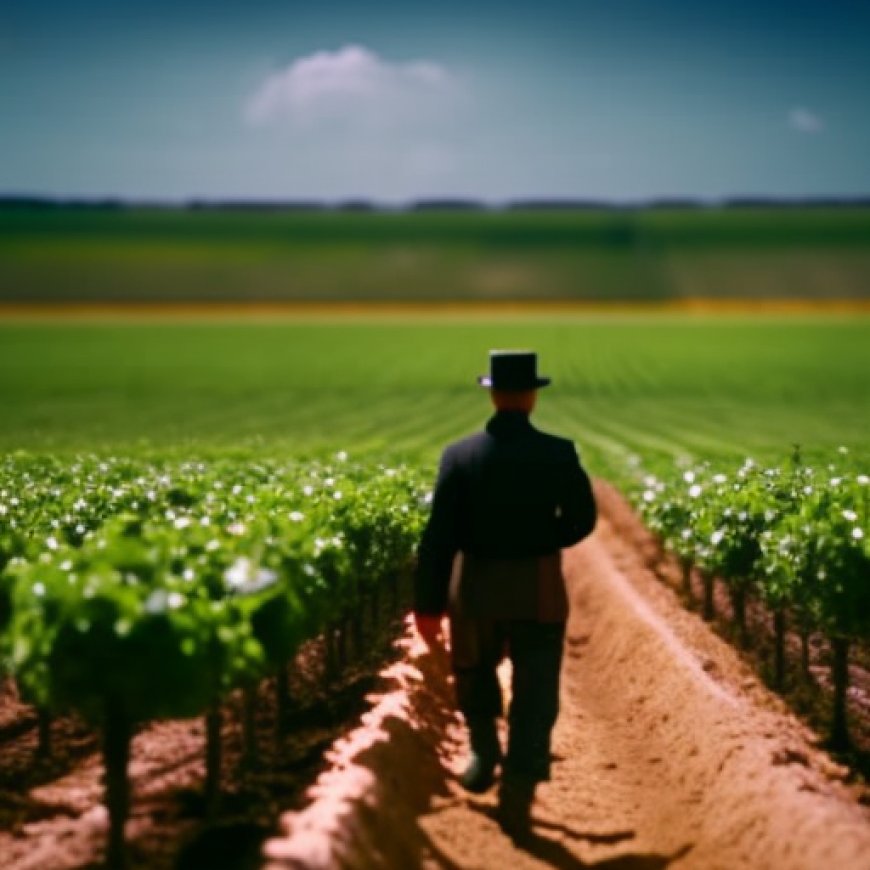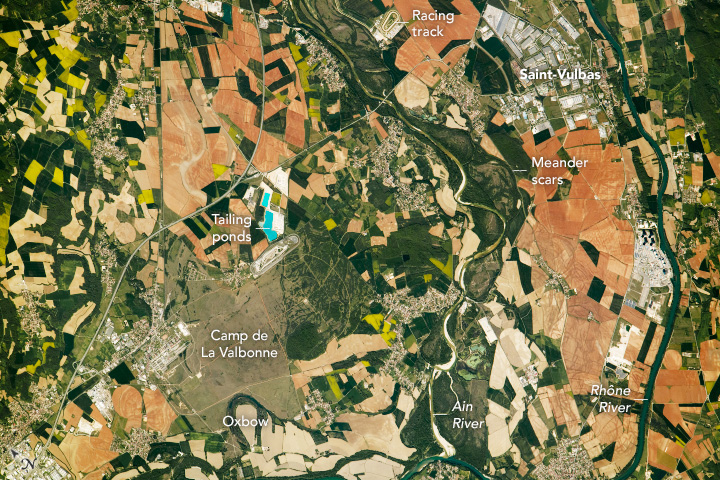Farming on Fertile Land in France
Farming on Fertile Land in France nasa.gov

 “`html
“`html
Report on Agricultural Region Near Lyon, France
Introduction
An astronaut aboard the International Space Station (ISS) captured a photograph of an agricultural region just outside of Lyon in east-central France in April 2022. The image highlights the fertile land of the Rhône River floodplain, which includes several smaller cities and towns.
Geographical Features and Water Bodies
The Rhône River skirts the perimeter of the image and is joined by the Ain River near the bottom of the scene. The Rhône River appears dark blue, while the Ain River has a brown hue due to its higher concentration of suspended sediment. The river floodplains include meander scars and oxbow cutoffs, several of which are filled with dark green vegetation.
Agricultural Landscape
Angular agricultural fields range from tan to green and vary in color due to primary crops such as:
- Wheat
- Barley
- Rapeseed
- Corn
- Sunflowers
Reddish agricultural plots indicate recent planting or tilling. The region’s mild climate, fertile soils, and abundant water sources make it an ideal place for farming.
Industrial and Military Sites
The large, dark feature on the left of the image is Camp de La Valbonne, a military site established over 150 years ago. Just north of this site, blue-toned tailings ponds support industries such as mining companies and concrete suppliers. A highway stretches across the image, connecting Lyon to industrial areas like the commune of Saint-Vulbas. An oval-shaped horse-racing track is visible northwest of the commune.
Sustainable Development Goals (SDGs)
- SDG 2: Zero Hunger
- The fertile lands and diverse agricultural activities contribute significantly to food production, supporting local and global food security.
- SDG 6: Clean Water and Sanitation
- The presence of the Rhône and Ain Rivers highlights the importance of sustainable water management practices in supporting agriculture and local communities.
- SDG 8: Decent Work and Economic Growth
- The agricultural and industrial activities in the region provide employment opportunities and contribute to economic growth.
- SDG 15: Life on Land
- The diverse vegetation and sustainable farming practices help preserve terrestrial ecosystems and biodiversity.
Image Details
Astronaut photograph ISS067-E-19015 was acquired on April 17, 2022, with a Nikon D5 digital camera using a focal length of 1,150 millimeters. It is provided by the ISS Crew Earth Observations Facility and the Earth Science and Remote Sensing Unit, Johnson Space Center. The image was taken by a member of the Expedition 67 crew. The image has been cropped and enhanced to improve contrast, and lens artifacts have been removed. The International Space Station Program supports the laboratory as part of the ISS National Lab to help astronauts take pictures of Earth that will be of the greatest value to scientists and the public, and to make those images freely available on the Internet. Additional images taken by astronauts and cosmonauts can be viewed at the NASA/JSC Gateway to Astronaut Photography of Earth. Caption by Sara Schmidt, GeoControl Systems, JETS Contract at NASA-JSC.
“`
SDG Analysis of the Article
1. Which SDGs are addressed or connected to the issues highlighted in the article?
- SDG 2: Zero Hunger
- SDG 6: Clean Water and Sanitation
- SDG 13: Climate Action
- SDG 15: Life on Land
2. What specific targets under those SDGs can be identified based on the article’s content?
- SDG 2: Zero Hunger
- Target 2.3: By 2030, double the agricultural productivity and incomes of small-scale food producers.
- Target 2.4: Ensure sustainable food production systems and implement resilient agricultural practices.
- SDG 6: Clean Water and Sanitation
- Target 6.3: Improve water quality by reducing pollution, eliminating dumping, and minimizing the release of hazardous chemicals and materials.
- SDG 13: Climate Action
- Target 13.1: Strengthen resilience and adaptive capacity to climate-related hazards and natural disasters in all countries.
- SDG 15: Life on Land
- Target 15.1: Ensure the conservation, restoration, and sustainable use of terrestrial and inland freshwater ecosystems and their services.
3. Are there any indicators mentioned or implied in the article that can be used to measure progress towards the identified targets?
- SDG 2: Zero Hunger
- Indicator 2.3.1: Volume of production per labor unit by classes of farming/pastoral/forestry enterprise size.
- Indicator 2.4.1: Proportion of agricultural area under productive and sustainable agriculture.
- SDG 6: Clean Water and Sanitation
- Indicator 6.3.2: Proportion of bodies of water with good ambient water quality.
- SDG 13: Climate Action
- Indicator 13.1.1: Number of deaths, missing persons, and directly affected persons attributed to disasters per 100,000 population.
- SDG 15: Life on Land
- Indicator 15.1.1: Forest area as a proportion of total land area.
- Indicator 15.1.2: Proportion of important sites for terrestrial and freshwater biodiversity that are covered by protected areas, by ecosystem type.
4. Findings from Analyzing the Article
| SDGs | Targets | Indicators |
|---|---|---|
| SDG 2: Zero Hunger | Target 2.3, Target 2.4 | Indicator 2.3.1, Indicator 2.4.1 |
| SDG 6: Clean Water and Sanitation | Target 6.3 | Indicator 6.3.2 |
| SDG 13: Climate Action | Target 13.1 | Indicator 13.1.1 |
| SDG 15: Life on Land | Target 15.1 | Indicator 15.1.1, Indicator 15.1.2 |
The article highlights the agricultural productivity in the Rhône River floodplain, the importance of water quality, climate conditions favorable for farming, and the conservation of terrestrial ecosystems, which align with the identified SDGs, targets, and indicators.
Copyright: Dive into this article, curated with care by SDG Investors Inc. Our advanced AI technology searches through vast amounts of data to spotlight how we are all moving forward with the Sustainable Development Goals. While we own the rights to this content, we invite you to share it to help spread knowledge and spark action on the SDGs.
Fuente: earthobservatory.nasa.gov

Join us, as fellow seekers of change, on a transformative journey at https://sdgtalks.ai/welcome, where you can become a member and actively contribute to shaping a brighter future.








